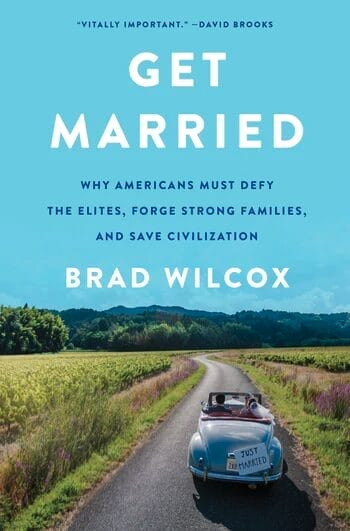This post originally appeared at https://www.badgerinstitute.org/marriage-the-old-fashioned-secret-path-to-happiness-and-prosperity/

Sociologist Brad Wilcox is modeling what he thinks more people with elevated platforms in American culture should do: He’s telling young people to marry because it will make them happier.
“There’s a big debate on whether marriage matters. Of course it does,” he told the Badger Institute in an interview. Marriage is a “transformative institution,” he said, with norms that tend to foster better behavior.
“But even more than that,” he said, “people who embrace the core values and virtues associated with marriage are more likely to flourish both in marriage and in life.”
Wilcox heads a research center, the National Marriage Project, at the University of Virginia, and is a nonresident senior fellow at the American Enterprise Institute (AEI), where he directs The Home Economics Project. Inaugurated in fall of 2013, the research project explores the links between family and the economy at home and abroad.

So he’s authoritative, and his new book has gotten enough attention that three New York Times staffers have centered opinion essays on it. The book’s title is the message: “Get Married.”
Americans are less likely to get married than in the past, and they are having many fewer children, Wilcox writes. On the whole, this does not make them happier; it makes them lonelier and more prone to ills such as anxiety. He quotes a financially successful man who, 34 and single, pines for meaning: “I’ve nothing to look forward to. Nope.”
Wilcox also brings data, ample amounts, to show that married people are better off financially, and socially and, more important, happier. He bats away a series of myths that circulate in pop culture — the “flying solo” myths that either men or women are better off without commitments to the other, the notion that family structure doesn’t matter in any way that love and money cannot overcome, the idea that marriage requires finding the one perfect “soulmate.”
Wilcox especially faults prominent people who have outsize power in public dialogue for not supporting marriage when it is central to their own private lives. He finds that Americans who are most likely to marry and to stay married are in at least one of four groups, one of which he labels “Strivers,” those with remunerative college degrees and “bourgeois values” of hard work and delayed gratification. People with a lot of cultural power often are Strivers, and while they disproportionately marry and stay married, many also publicly display liberal attitudes toward family structure at odds with how they personally live.
For some, he said, it’s a lack of courage: “You don’t want to say anything in public that’s too conservative,” a reluctance to speak on behalf of marriage. Others, he ventures, “are genuinely convinced that family structure isn’t that important,” that “every new development that comes down the pike ought to be baptized and made worthy of approval.”
“There’s a reluctance to grapple with the reality that some of these forms are a problem for children,” he said.
So Americans are fed dystopian entertainment that centers unhappy couples and polyamory, he said, at odds with the family forms and norms that will offer the best chance at a happy life.
Who marries?
The other three groups of people with a strong correlation to marrying, Wilcox writes, are those who hold “traditional” views about personal responsibility, gender roles and sex; Asian-American immigrants and their children who embrace particular traditions about hard work and the primacy of family; and religious believers who regularly attend church, synagogue or mosque.
Mostly, Wilcox’s point is to offer a book-length case for marriage as a beneficial thing for the men and women in it and the children raised in it, and to exhort those aren’t married to have the courage to “seek out one worthy of your heart, and get married.”
What to do
Wilcox suggests changes to policies that discourage marriage.
Sporadic employment or unemployment is a genuine barrier to a man being marriageable, Wilcox writes. That they might earn more than a husband doesn’t bother most women, but they do want a man who works and earns steadily. This is bad news for young men who fall prey to the easy pleasure of Xbox or porn and who weren’t inclined toward the four-year college path. Wilcox calls for a shift of more public resources to career and technical education opportunities for young men who’d thrive in work that doesn’t involve sitting at a desk.
He also suggests increasing the federal child tax credit, making it still larger if parents are married, as well as eliminating the marriage penalties in the phase-out schedules of public benefits.
He favors school choice, and he urges a public-education campaign, comparable to the attack on smoking, to promote the “success sequence” of finishing education, then marrying, and only then having children.
And he favors Americans speaking up for marriage: “It will take courage to publicly defy the elite ‘wisdom’ on marriage, family life, and gender in the public square,” he writes.
“But the future of the American way of life” depends on people doing it.
Patrick McIlheran is the Director of Policy at the Badger Institute. Permission to reprint is granted as long as the author and Badger Institute are properly cited.
Submit a comment
“*” indicates required fields
/* = 0;if(!is_postback){return;}var form_content = jQuery(this).contents().find(‘#gform_wrapper_21’);var is_confirmation = jQuery(this).contents().find(‘#gform_confirmation_wrapper_21’).length > 0;var is_redirect = contents.indexOf(‘gformRedirect(){‘) >= 0;var is_form = form_content.length > 0 && ! is_redirect && ! is_confirmation;var mt = parseInt(jQuery(‘html’).css(‘margin-top’), 10) + parseInt(jQuery(‘body’).css(‘margin-top’), 10) + 100;if(is_form){jQuery(‘#gform_wrapper_21’).html(form_content.html());if(form_content.hasClass(‘gform_validation_error’)){jQuery(‘#gform_wrapper_21’).addClass(‘gform_validation_error’);} else {jQuery(‘#gform_wrapper_21’).removeClass(‘gform_validation_error’);}setTimeout( function() { /* delay the scroll by 50 milliseconds to fix a bug in chrome */ jQuery(document).scrollTop(jQuery(‘#gform_wrapper_21’).offset().top – mt); }, 50 );if(window[‘gformInitDatepicker’]) {gformInitDatepicker();}if(window[‘gformInitPriceFields’]) {gformInitPriceFields();}var current_page = jQuery(‘#gform_source_page_number_21’).val();gformInitSpinner( 21, ‘https://e74sq7k37a8.exactdn.com/wp-content/plugins/gravityforms/images/spinner.svg’, true );jQuery(document).trigger(‘gform_page_loaded’, [21, current_page]);window[‘gf_submitting_21’] = false;}else if(!is_redirect){var confirmation_content = jQuery(this).contents().find(‘.GF_AJAX_POSTBACK’).html();if(!confirmation_content){confirmation_content = contents;}jQuery(‘#gform_wrapper_21’).replaceWith(confirmation_content);jQuery(document).scrollTop(jQuery(‘#gf_21’).offset().top – mt);jQuery(document).trigger(‘gform_confirmation_loaded’, [21]);window[‘gf_submitting_21’] = false;wp.a11y.speak(jQuery(‘#gform_confirmation_message_21’).text());}else{jQuery(‘#gform_21’).append(contents);if(window[‘gformRedirect’]) {gformRedirect();}}jQuery(document).trigger(“gform_pre_post_render”, [{ formId: “21”, currentPage: “current_page”, abort: function() { this.preventDefault(); } }]); if (event && event.defaultPrevented) { return; } const gformWrapperDiv = document.getElementById( “gform_wrapper_21” ); if ( gformWrapperDiv ) { const visibilitySpan = document.createElement( “span” ); visibilitySpan.id = “gform_visibility_test_21”; gformWrapperDiv.insertAdjacentElement( “afterend”, visibilitySpan ); } const visibilityTestDiv = document.getElementById( “gform_visibility_test_21” ); let postRenderFired = false; function triggerPostRender() { if ( postRenderFired ) { return; } postRenderFired = true; jQuery( document ).trigger( ‘gform_post_render’, [21, current_page] ); gform.utils.trigger( { event: ‘gform/postRender’, native: false, data: { formId: 21, currentPage: current_page } } ); if ( visibilityTestDiv ) { visibilityTestDiv.parentNode.removeChild( visibilityTestDiv ); } } function debounce( func, wait, immediate ) { var timeout; return function() { var context = this, args = arguments; var later = function() { timeout = null; if ( !immediate ) func.apply( context, args ); }; var callNow = immediate && !timeout; clearTimeout( timeout ); timeout = setTimeout( later, wait ); if ( callNow ) func.apply( context, args ); }; } const debouncedTriggerPostRender = debounce( function() { triggerPostRender(); }, 200 ); if ( visibilityTestDiv && visibilityTestDiv.offsetParent === null ) { const observer = new MutationObserver( ( mutations ) => { mutations.forEach( ( mutation ) => { if ( mutation.type === ‘attributes’ && visibilityTestDiv.offsetParent !== null ) { debouncedTriggerPostRender(); observer.disconnect(); } }); }); observer.observe( document.body, { attributes: true, childList: false, subtree: true, attributeFilter: [ ‘style’, ‘class’ ], }); } else { triggerPostRender(); } } );} );
/* ]]> */
The post Marriage: The old-fashioned, secret path to happiness and prosperity appeared first on Badger Institute.
